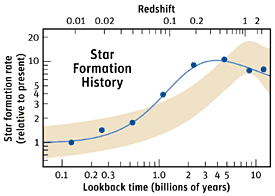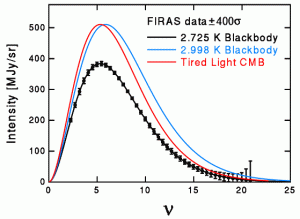A ring of nine gamma-ray bursts (GRBs) has been observed in the southern hemisphere. The ring is more than 5 billion light years across, which is larger than we’d expect for a cosmic structure. But it’s important not to read too much into this discovery.
Gamma-ray bursts are extremely intense but short lived bursts of gamma rays. We’ve been able to observe them since the 1960s, but their cause is still a bit of a mystery. They are likely caused by the hypernova explosion of a large star as it collapses into a black hole. While it was once thought that GRBs might occur randomly in the sky, we’ve seen that they tend to be clustered in the same way that galaxies are. This is what you’d expect if such stars are located in galaxies, as most stars are.
Which brings us to this latest discovery. The light from these GRBs all traveled about 7 billion years to reach us, give or take about 200 million years, and they span more than 5 billion light years in space. If these GRBs are associated with galaxies as we expect, then this would imply a large-scale structure of galaxies across this scale. This would be surprising, because on large scales the universe appears to be uniform. This large scale uniformity is known as the cosmological principle, and it would seem that this GRB ring violates that principle. In fact the team calculates that the chance of such a pattern forming randomly is 1 in 200,000.
While this seems to be pretty conclusive on the face of it, you have to be careful when applying statistical odds to the universe as a whole. We’ve seen several examples of “statistically anomalous” patterns in cosmic data, and they aren’t as unusual as they first seem. In this case, the assumption that a large pattern implies a large structure is a bit tenuous. The work calculates odds based upon a random distribution, but we know that star production actually peaked around the the redshift range of these GRBs. If GRBs are indeed the result of large exploding stars, then it is more likely to find them in the period of peak star production, and such large patterns are more likely due to a random distribution.
That doesn’t mean we can simply ignore this result. It is possible that this pattern could imply a violation of the cosmological principle, but this particular study isn’t conclusive.
Paper: L. G. Balázs, et al. A giant ring-like structure at 0.78 < z < 0.86 displayed by GRBs. MNRAS 452 (3): 2236-2246 (2015).













Comments
Full PDF of the paper is here.
http://mnras.oxfordjournals.org/content/452/3/2236.full.pdf
I’d wondered whether we were talking about a spherical shell or a genuine ring. The authors do deal with this question, though perhaps not conclusively.
thanks.other/articles/didn’t/explain/why/it/was/thought/to/be/part/of/one/”structure.”